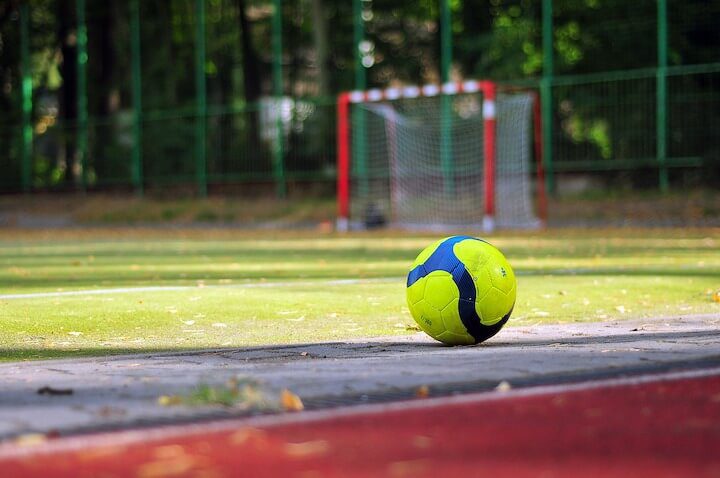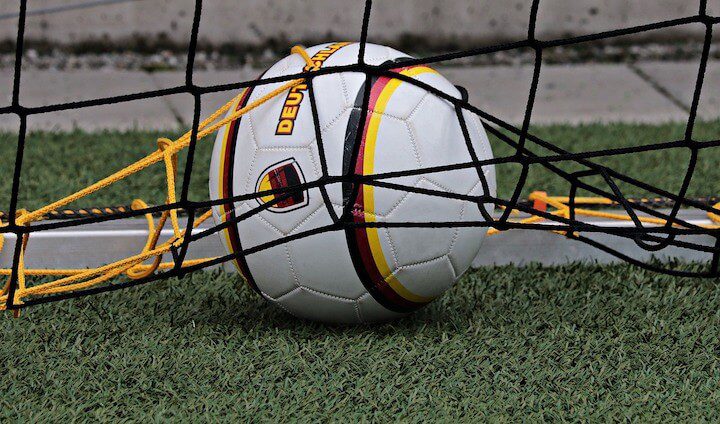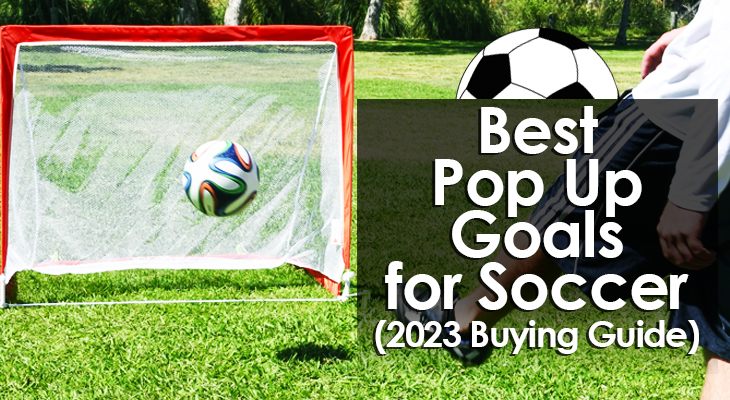The Best Pop Up Goals for Soccer (2023 Buying Guide)
Soccer is a simple game you can play virtually anywhere, as long as you have a ball.
Many players spend their free time playing in kickabouts with their friends, using “jumpers for goalposts”.
Although there’s nothing wrong with this approach, today you can find very affordable and durable pop up goals that take backyard soccer to a new level.
Moreover, a pop up goal is an excellent addition to your training session -- for small-sided games, passing drills, and even full-on scrimmages.
They cost a fraction of the price of heavy-duty goal frames and take just seconds to set up.
Whether you’re upgrading your personal practice space or want some highly effective but low-cost equipment for your team, consider investing in pop up goals.
Below, I outline what makes a good pop up goal and take you through several different styles to help you find the model that fits your needs.
Best Pop Up Goals for Soccer
Pop up goals are essentially easy-to-assemble soccer goals you can transport and set up anywhere.
But while similar in design, they’re not all the same.
Several factors come into play when choosing the right pop up goal for you.
In this buying guide, I’ve included multiple options so you can find one that fits your specific needs and budget.

#1 - Large Pop Up Goal for Target Practice
If you plan to use the goal specifically for shooting practice, you’ll need a pop up that’s large and sturdy with a strong net and tie-downs or peg hooks.
If your budget allows it, go for a steel or fiberglass frame.
Ensure it can stand up to frequent use, adverse weather, and wear and tear from transport.
With a target practice goal, the assembly may be a little trickier than with a kids’ pop up.
However, the extra setup time is worth it if you plan to do a lot of shooting.
Ensure it comes with a carry bag if you intend to take it to and from training.
In terms of size, 6’x3’ should be the minimum.
Any smaller and the goal won’t replicate a real-game scenario.
PROS |
|---|
Large enough for target practice |
Usable in the backyard or training field |
Made from sturdy material like steel |
Also works for goalkeeper practice |
CONS |
|---|
Assembly time may be a little longer |
Larger, more stable frame usually means a higher price |
May be too big for small outdoor areas |
#2 - Mini Collapsible Goal Set
Mini collapsible goal sets are about as convenient as it gets with pop ups.
They require zero assembly time. Just twist or pop them to set them up or take them down.
This type of pop up goal is usually designed for skills-based training or kids’ soccer.
The reason for this is that they’re small and lightweight, usually available in sizes between 2’ and 6’.
Collapsible goals come in different shapes, including rectangular and round.
Although some have nets, many have a reflective plastic curved mesh that attaches directly to the frame, making them usable even at night.
Because these goals are so light, it’s imperative that you choose one with pegs or pins to secure them in place.
These sets are perfect for mini-possession games and passing drills and require little to no extra effort to take to training.
PROS |
|---|
Cheaper than most other pop up models |
Perfect for kids’ soccer and skills training |
Small and compact |
Easy to transport |
Available in multiple shapes and sizes |
CONS |
|---|
Extremely lightweight |
Unsuitable for hard shooting practice |
Much small than regulation goals |
#3 - Steel Frame Pop Up
For coaches, a steel frame pop up is a must.
Mini goals serve a purpose in training but they won’t withstand regular use with competitive teams.
Steel frames provide a sturdy base that will stand up to powerful shots and scrimmages. The thicker the frame, the stronger the goal.
However, it’s also important to think about the weight if you need to take the goal to and from practice fields regularly.
With this type of goal, you should also consider the joints and units that connect each part.
These should be airtight or else the structural integrity of the goal might give in after a couple of hard shots.
Typically, steel frame goals come in a range of sizes, with some brands producing full-size options.
These types of goals are usually more expensive than mini or plastic models and they don’t always come with nets.
PROS |
|---|
Sturdy and suitable for competitive practices |
Available in multiple sizes |
Excellent option for shooting and goalkeeper practice |
Can stand up to tough weather conditions |
CONS |
|---|
Higher price point |
Can take longer to assemble |
Heavier and not as mobile |
Frequent Use May Compromise Corner joints |
#4 - Lightweight Fiberglass Goal
Over the last decade, several goal manufacturers have built goals using fiberglass as a lightweight alternative to steel.
Fiberglass is exceptionally strong and durable so it can withstand regular use, like weekly training.
The best part about it is that it’s much lighter than steel or aluminum, making it a perfect option for transporting to and from the field.
Fiberglass goals come in multiple parts that can be stored in a carry bag.
Set up should only take a few minutes but depending on the size of the frame, you may need some help.
The poles typically slot and clip into one another so there’s no need for assembly tools.
Although it’s strong enough for team training, this type of frame is better for individual sessions as it is likely to break down faster than steel.
PROS |
|---|
Strong but lightweight |
Easy To Transport |
Available In Large Sizes |
Quick Set Up |
CONS |
|---|
May require pegs to hold down |
High Price Point |
Fiberglass Poles May Bend, Causing The Shape Of The Goal To Change |

What to Consider When Buying Pop Up Goals
Some pop up goals are meant to replicate actual game-day goalposts while others are more suited for specific target practice and passing drills.
Likewise, several models suit backyard play and others serve more professional training settings.
So before you decide on a set, be sure to know exactly what you’re looking for, or more specifically, what you intend to use the goals for.
Here are several key factors to look out for in pop up goals for soccer.
a. Size and Shape
Pop up goals for soccer come in a variety of shapes and sizes.
Depending on what available space you have and what you intend to use the goal for, you may need a certain size.
For example, if you’re buying for kids or you have a small backyard, a 4’x3’ goal should suffice.
However, if you want a portable and lightweight, yet large goal for shooting practice, consider a 12’x6’ frame.
Although they’re not full-size, big pop ups are perfect for practicing finishing, penalties, or free kicks from a range of distances.
Large pop ups are also great for goalkeeper practice.
Some pop up goals have a rectangular shape, just like a regular goal frame.
Others have a more oval-style shape.
These are generally used for mini-games without goalkeepers or for passing practice.
b. Maneuverability
Many players and coaches purchase pop up goals because of their portability.
They're easy to assemble or disassemble in seconds, then packed away and transported by hand or in a bag.
Don’t underestimate the importance of maneuverability.
A fast-assemble set can save you a lot of time before and after practice.
Moreover, a portable pop up goal is easy to take with you, whether you’re traveling to a training camp or simply meeting some friends for a pickup game.
When choosing a goal, check if it comes with a travel bag.
A bag not only improves portability, but it also protects your goal when it's not in use.
c. Durability
The durability and general stability of pop up goals are extremely important.
Designed to be portable and cheap, you can’t expect pop up goals to be as solid as regular goals. That said, you should always prioritize quality.
Some pop up goals are basically kids' toys and serve little to no purpose for actual soccer players.
Don’t let a low price point fool you.
Ensure the goal frames are sturdy and durable, preferably made from lightweight steel.
Check that the net is strong enough to withstand continuous powerful shots.
It’s also beneficial to find a goal with stakes that can secure the frame to the ground.
This is especially important for lightweight goals.
Otherwise, they can become a safety hazard in bad weather or if a hard shot hits the back of the net.
d. Ease of Set Up
Most pop up goals for soccer are easy to set up and require minimal assembly equipment.
This is especially true for the smaller, foldable types.
However, some of the larger, steel-framed goals may require assembly and potentially some equipment.
Moreover, due to their size, setting them up can be a little tricky without help.
If you’re practicing solo or want a goal for weekly training sessions, prioritize ease of assembly.
Small pop up goals for kids usually pop up or fold down with a simple mechanism, mitigating any setup time.
d. Price
Price is always an important factor when buying soccer equipment.
While brand names can be a good indicator of quality, this isn’t always the case.
My advice would be to do your research, determine what features you need, and set a budget.
That way, you’re less likely to be swayed by a logo.
Pop up goals for soccer are available for as little as $20 but prices can climb all the way to $1,000 and beyond.
In general, cheaper sets are designed for occasional use or backyard soccer with kids.
Expensive goals emulate gameday equipment and are more suited to competitive team practice.
Fortunately, there is a happy medium for pop up goals and you’re sure to find a set that fits your budget.
Conclusion
Pop up goals for soccer are a youth coach’s dream.
Available in a range of sizes, these goals can be set up in minutes, moved in seconds, and transported to and from the field with minimal effort.
What’s more, they typically come with carry bags, helping keep all the key components in place.
Although there’s no substitute for a full-size steel goal, pop ups are a more convenient and cost-effective option.
Set one up in your back yard and watch your shooting and passing accuracy improve within weeks.

